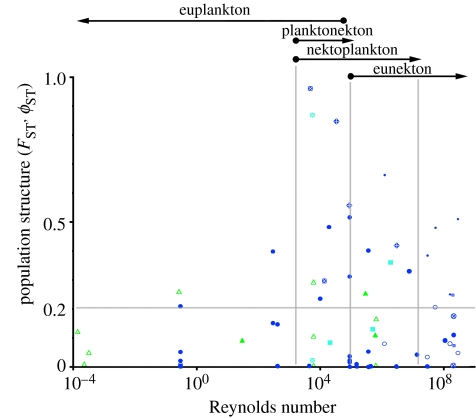Figure 6.
Relationship between Reynolds number (Re) and population subdivision (FST or ϕST) for some marine (dark blue circles), freshwater (light blue squares) and terrestrial (green triangles) organisms. Organisms with very small Re, such as marine and aerial microplankton, are unable to influence fluid dispersal and are expected to have high gene flow (low FST and ϕST) and very large geographical ranges. Organisms with very large Re, such as marine mammals and large birds, have locomotory abilities that far exceed the influence of fluid dispersal and are also expected to have high gene flow and very large geographical ranges. These taxa with potentially high dispersal typically have FST or ϕST less than 0.2 (see light grey horizontal line), indicating at least one successful migrant per generation, i.e. sufficient in theory to prevent geographical differentiation. Organisms with intermediate Re, such as large insects, small birds and many reef fishes, are often able to avoid passive fluid dispersal but unable to move very large distances due to biomechanical or energetic restrictions; they are expected to have various degrees of connectivity and range-sizes, including many instances of low gene flow (high FST and ϕST). The light grey vertical lines delimit the different classes of motility identified by Aleyev (1977). Differences in population subdivision between organisms with similar Re may indicate the influences of behaviour, life history, physical discontinuities (environmental filters), chance and other events on gene flow. Solid symbols, mitochondrial DNA; open symbols, nuclear DNA. Note that estimates of gene flow in marine mammals based on analyses of mitochondrial DNA (small solid circles) are inflated relative to those based on nuclear DNA due to female social structure (e.g. Bérubé et al. 1998; Burg et al. 1999; Durand et al. 2005). Pairs of crossed squares and circles with the same or similar Re highlight examples in which physical isolation or environmental filters contribute to high population subdivision (Bérubé et al. 1998; Dawson et al. 2002; Dawson & Hamner 2005). Crossed diamonds show examples in which life histories, in these cases vivipary or brooding or adult migration, contribute to high population subdivision (Bernardi 2000; Planes et al. 2001; Bowen et al. 2005).

